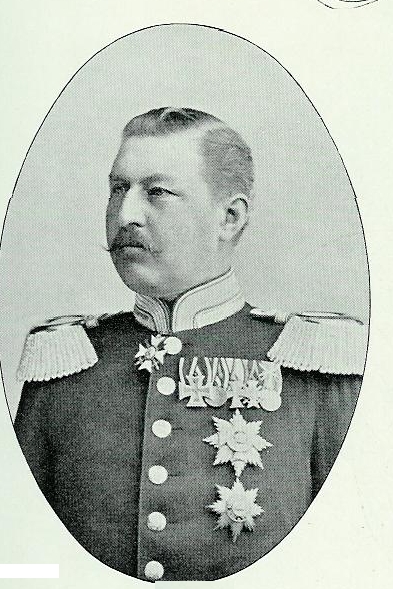by Susan Flantzer
Principality of Schwarzburg-Rudolstadt and the Principality of Schwarzburg-Sondershausen: The County of Schwarzburg was a state of the Holy Roman Empire from 1195 to 1595, when it was partitioned into Schwarzburg-Rudolstadt and Schwarzburg-Sondershausen. The new counties remained in the Holy Roman Empire until its dissolution. In 1697, the County of Schwarzburg-Sondershausen was elevated to the Principality of Schwarzburg-Sondershausen. The County of Schwarzburg-Rudolstadt was elevated to the Principality of Schwarzburg-Rudolstadt in 1710.
The death of Karl Günther, Prince of Schwarzburg-Sondershausen without an heir in 1909 caused the Principalities of Schwarzburg-Rudolstadt and Schwarzburg-Sondershausen to be united under Günther Victor, Prince of Schwarzburg-Rudolstadt in a personal union. Following his succession in Sondershausen, Prince Günther Victor dropped the name Rudolstadt from his title and assumed the title Prince of Schwarzburg.
At the end of World War I, Prince Günther Victor was the last German prince to renounce his throne, abdicating on November 22, 1918. He made an agreement with the government that awarded him an annual pension and the right to use several of the family residences. The territory that encompassed the Principalities of Schwarzburg-Rudolstadt and Schwarzburg-Sondershausen is now located in the German state of Thuringia.
*********************

Credit – Wikipedia
Anna Luise of Schönburg-Waldenburg was the wife of Günther Victor, the last sovereign Prince of both the Principality of Schwarzburg-Rudolstadt and the Principality of Schwarzburg-Sondershausen and was styled Princess of Schwarzburg. As a widow, Anna Luise was forced by the Nazis to leave Schwarzburg Castle so it could be demolished and Adolf Hitler’s Imperial Guest House built. The castle was demolished but the guest house was never completed. She spent the last years of her life living under the Communist regime of the German Democratic (East Germany).
Born on February 19, 1871, at Hermsdorf Castle (link in German) near Dresden, Kingdom of Saxony, now in the German state of Saxony, she was the only daughter and the youngest of the three children of Prince Georg of Schönburg-Waldenburg and Princess Luise of Bentheim-Tecklenburg.
Anna Luise had two older brothers:
- Hermann of Schönburg-Waldenburg (1865 – 1943), married Thekla von Rothenberg, no children
- Ulrich Georg of Schönburg-Waldenburg (1869 – 1939), married Pauline of Löwenstein-Werthelm-Freudenberg, had five children

Hermsdorf Castle; Credit – Von X-Weinzar – Selbst fotografiert, CC BY-SA 2.5, https://commons.wikimedia.org/w/index.php?curid=6921372
Anna Luise grew up with her two brothers at Hermsdorf Castle, her birthplace, and Schneeberg in the Austrian Alps. From the age of six, she was taught together with her brother Ulrich Georg and several other children. Besides academic subjects, Anna Luise also had music and drawing lessons.
On December 9, 1891, in Rudolstadt, Principality of Schwarzburg-Rudolstadt, 20-year-old Anna Luise married her 39-year-old first cousin Günther Victor, the reigning Prince of Schwarzburg-Rudolstadt. Six months later, her pregnancy was happily announced. However, in the seventh month of pregnancy, Anna Luise suffered a stillbirth. It had been a boy who would have ensured the Schwarzburg-Rudolstadt succession. After the stillbirth, Anna Luise developed puerperal fever (childbed fever) along with pleurisy and cardiac issues. Afterward, Anna Luise was unable to have children which was a dynastic catastrophe for the House of Schwarzburg-Rudolstadt.
To ensure the continued existence of the House of Schwarzburg, Prince Sizzo of Leutenberg was appointed as Günther Victor’s successor by law on June 1, 1896, and was recognized as a member of the House of Schwarzburg. Prince Sizzo was the only son of Friedrich Günther, reigning Prince of Schwarzburg-Rudolstadt from a morganatic marriage. Sizzo and his twin sister were created Prince and Princess of Leutenberg shortly after their birth but Sizzo did not have succession rights due to his parents’ morganatic marriage.
After he was recognized as a member of the House of Schwarzburg, Sizzo was able to use the title of Prince of Schwarzburg. Following the agreement, Sizzo became the heir presumptive of the Principality of Schwarzburg-Rudolstadt, ahead of the Schwarzburg-Sondershausen princes, and third in line to the Principality of Schwarzburg-Sondershausen. Following the death of Prince Karl Günther of Schwarzburg-Sondershausen in 1909, Günther Victor became Prince of Schwarzburg-Sondershausen and Prince Sizzo became the heir presumptive to the two principalities. However, over time, the relationship between the cousins Sizzo and Günther Victor deteriorated. Sizzo felt deprived for no valid reason. After a dispute, Günther Victor refused to allow Sizzo to stay in the castles in Rudolstadt and Schwarzburg. In 1918, their relationship had so deteriorated that they only came to an understanding through lawyers.
Anna Luise took on the role of mother of the country and became beloved by the people. She was the patron of various non-profit institutions and charities such as a social welfare facility for the elderly and poor in Quittelsdorf and the Anna Luise Nursing Home in Bad Blankenburg. During World War I, Anna Luise established the Anna Luise Medal given to women who cared for wounded soldiers.
When Prince Leopold of Schwarzburg-Sondershausen died in 1906, Günther Victor became heir presumptive to the Principality of Schwarzburg-Sondershausen. He succeeded in 1909 as Prince of Schwarzburg-Sondershausen, upon the death of Karl Günther, Prince of Schwarzburg-Sondershausen. The two Schwarzburg principalities were united under Günther Victor in a personal union and he was then styled Prince of Schwarzburg.

Günther Victor and Anna Luise; Credit – Wikipedia
After the defeat of the German Empire in World War I, the November Revolution of 1918 led to the end of all the German monarchies. On November 23, 1918, Günther Victor abdicated the throne of Schwarzburg-Rudolstadt and on November 25, 1918, he abdicated in Schwarzburg-Sondershausen. Günther Victor made an agreement with the new government that awarded him an annual pension and the right to use several of the family residences. Günther Victor and Anna Luise retained ownership of Schwarzburg Castle (link in German) and Rothsfeld Hunting Lodge (link in German) and their associated lands and also had the right of residence in Heidecksburg Castle (link in German) and Sondershausen Castle. Anna Luisa accepted the forced loss that she and her husband had suffered with a heavy heart. According to her, the new government of the State of Thuringia only wanted to keep them as “historical oddities.”
Günther Victor died after a long illness on April 21, 1925, aged 72, at Sondershausen Castle in Sondershausen, Thuringia, Germany, and was buried at the Stadtkirche St. Andreas (link in German) in Rudolstadt, Germany. Prince Sizzo became Head of the House of Schwarzberg. Günther Victor had made Anna Luise his sole heir and so she had to continue the legal battle with Prince Sizzo. In 1926, Prince Sizzo died and Anna Luise ruled out the adoption of Prince Sizzo’s only son Prince Friedrich Günther who succeeded as Head of the House of Schwarzberg. She continued her husband’s original legal battles with Prince Sizzo with his son. In 1942, Anna Luise decided to adopt as her heir Prince Wilhelm of Schönburg-Waldenburg, the youngest son of her brother Ulrich.

Schwarzburg Castle in the 1930s; Credit – Wikipedia
After Günther Victor died in 1925, Anna Luise was allowed to continue to live in Schwarzburg Castle (link in German). This right of residence was initially not curtailed when the Nazis came to power in 1933. Anna Luise was not a supporter of the Nazi Party. In 1940, the Nazis planned to demolish Schwarzburg Castle and build an Imperial Guest House for Adolf Hitler in its place. Anna Luise had to leave the castle within a few days for financial compensation. In June 1940, demolition began on Schwarzburg Castle, one of the most important Baroque castles in central Germany. The remains of the Schwarzburg-Rudolstadt family buried at the Schlosskirche Schwarzburg (castle church) were moved to Stadtkirche St. Andreas in Rudolstadt, Thuringia, Germany. In 1942, the construction was stopped and the Imperial Guest House was never finished. The ruins of the castle and the incomplete construction of the guest house were left for years. The only thing that remained of the castle church was the tower dome but it was destroyed in a fire caused by fireworks on New Year’s Eve 1980. There has been much reconstruction work done on the castle especially after Schwarzburg Castle was transferred to the Thuringian Palaces and Gardens Foundation in 1994.

Sondershausen Castle, Anna Luise’s last home; Credit – Von HieRo GlyPhe – Eigenes Werk, CC BY-SA 3.0, https://commons.wikimedia.org/w/index.php?curid=10958015
After World War II, the area that had encompassed the Principalities of Schwarzburg-Rudolstadt and Schwarzburg-Sondershausen were in the newly formed German Democratic Republic, also known as East Germany, and a satellite state of the Soviet Union. Soviet occupation authorities began transferring administrative responsibility to German communist leaders in 1948. In 1945, most of the Schwarzburg property was expropriated and the ownership was transferred to the government. Until her death, Anna Luise was allowed to reside in Sondershausen Castle (link in German).

Anna Luise in 1950; Credit – https://www.thueringen.de/
Anna Luise, aged 80, died November 7, 1951, in Sondershausen Castle in Sondershausen, East Germany, now in the German state of Thuringia. She was buried at the Stadtkirche St. Andreas in Rudolstadt, East Germany, now in the German state of Thuringia. Although news of her death was kept secret by the Stasi, the state security police of the German Democratic Republic (East Germany), the streets of Rudolstadt were full of people who paid her their last respects and there was standing room only for her funeral at the Stadtkirche St. Andreas.

Stadtkirche St. Andreas; Credit – Wikipedia
This article is the intellectual property of Unofficial Royalty and is NOT TO BE COPIED, EDITED, OR POSTED IN ANY FORM ON ANOTHER WEBSITE under any circumstances. It is permissible to use a link that directs to Unofficial Royalty.
Schwarzburg-Rudolstadt/Schwarzburg-Sondershausen Index Resources at Unofficial Royalty
- Principality of Schwarzburg-Rudolstadt Index
- Principality of Schwarzburg-Sondershausen Index
- Royal Burial Sites of the Principality of Schwarzburg-Rudolstadt
- Royal Burial Sites of the Principality of Schwarzburg-Sondershausen
Works Cited
- De.wikipedia.org. 2020. Anna Luise Von Schwarzburg. [online] Available at: <https://de.wikipedia.org/wiki/Anna_Luise_von_Schwarzburg> [Accessed 3 November 2020].
- De.wikipedia.org. 2020. Günther Victor (Schwarzburg-Rudolstadt). [online] Available at: <https://de.wikipedia.org/wiki/G%C3%BCnther_Victor_(Schwarzburg-Rudolstadt)> [Accessed 3 November 2020].
- De.wikipedia.org. 2020. Schloss Schwarzburg. [online] Available at: <https://de.wikipedia.org/wiki/Schloss_Schwarzburg> [Accessed 5 November 2020].
- Es.wikipedia.org. 2020. Ana Luisa De Schönburg-Waldenburg. [online] Available at: <https://es.wikipedia.org/wiki/Ana_Luisa_de_Sch%C3%B6nburg-Waldenburg> [Accessed 5 November 2020].
- Flantzer, Susan. 2020. Günther Victor, Prince of Schwarzburg. [online] Unofficial Royalty. Available at: <https://www.unofficialroyalty.com/gunther-victor-prince-of-schwarzburg/>
- Flantzer, Susan, 2020. Royal Burial Sites Of The Principality Of Schwarzburg-Rudolstadt. [online] Unofficial Royalty. Available at: <https://www.unofficialroyalty.com/royal-burial-sites/royal-burial-sites-of-the-principality-of-schwarzburg-rudolstadt/> [Accessed 4 November 2020].
























